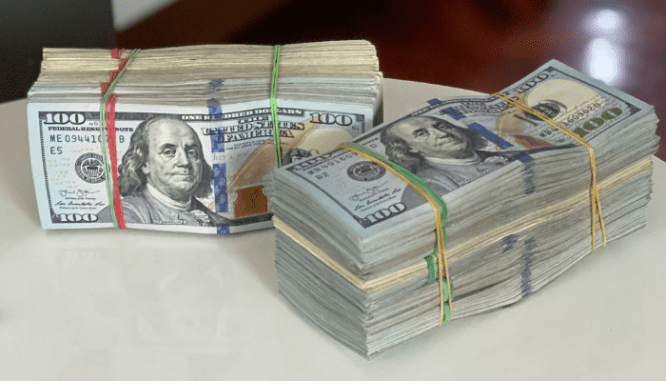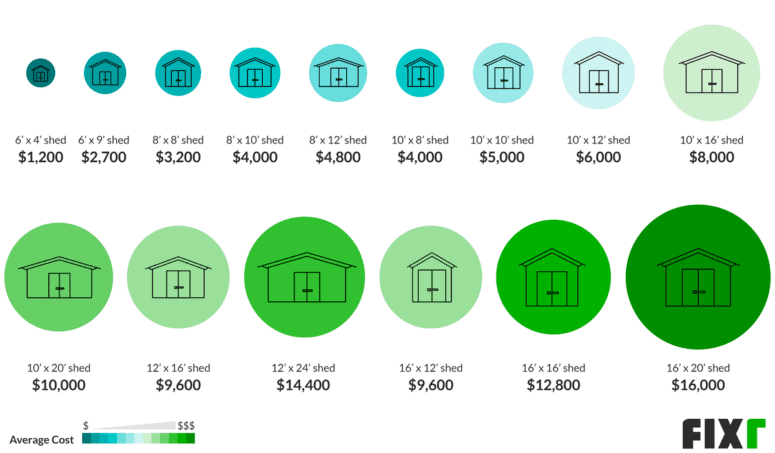The Cost to Build a Shed for Overflow Storage or Extra Living Space
- Published on
- 7-8 min read
-
 Melissa Rudy Contributing AuthorClose
Melissa Rudy Contributing AuthorClose Melissa Rudy Contributing Author
Melissa Rudy Contributing AuthorMelissa Rudy is a seasoned digital journalist with 15 years of experience writing web copy, blog posts and articles for a broad range of companies. When she can’t buy or sell homes, she settles for the next-best thing: researching and writing about all things real estate-related.
We’ve all heard about the “she-shed” craze over the past couple of years — but even if you’re not a she, you might be in the market for a backyard shed. Beyond obvious uses like storing lawn, garden, and pool equipment, a well-appointed shed can serve as a spare kitchen, massage studio, child’s playhouse, living space, or even a small business headquarters.
The pandemic has been a boon to the shed industry. A quick glance at Google Trends shows that searches for “sheds” ticked up dramatically in the spring of 2020, as employees found themselves stuck at home and in need of extra office space. And reports have shown that shed manufacturers have seen business skyrocket as cooped-up homeowners scramble to add extra square footage to their backyards.
If you’re ready to join the #shedlife movement, one of your first questions is likely, “what’s the cost to build a shed?” According to HomeAdvisor, the average national price to build a shed is $2,500, but the cost can range from $200 to $30,000, depending on materials, complexity, and your contractor’s pricing structure.
We talked to some shed-building experts, took a deep dive into online pricing information, and crunched the numbers to help you determine whether this project is within your budget.

Overview of the cost to build a shed
We checked some of the top online pricing sites to help you get a ballpark idea of what it might cost to have a shed built:
Source: HomeAdvisor
Average cost to build a shed: $2,500
Average cost per square foot: $15-$150
Low- to high-end cost range: $200-$30,000
Methodology: HomeAdvisor gathers millions of real project costs from real homeowners in more than 10,000 U.S. cities and towns.
Source: Fixr
Average cost to build a shed: $5,650
Average cost range: $1,500-$10,000
Low- to high-end cost range: $1,321-$33,764
Average cost per square foot: $50-$200
Methodology: The information provided by Fixr’s cost guides comes from a variety of sources, including “specialized books and websites, published cost studies, U.S. associations, websites and reports from the U.S. government, literature reviews of DIY websites, contractors and subcontractors, material suppliers, material price services, and other vendor websites.”
Source: Thumbtack
Median cost: $8,250
Average cost range: $1,500-$15,000
Average cost per square foot: $17-$24
Methodology: Millions of people ask Thumbtack for help with their projects every year. The website tracks the estimates users get from local professionals and shares those prices on its website.
Source: Costimates
Average cost: $2,880
Average cost range: $980-$5,200
Average cost per square foot: $30
Methodology: Costimates gathers home improvement cost estimates from homeowners and pros and shares them online to help homeowners learn, plan, budget, and compare repair pricing and replacement costs.
Source: Improvenet
Average cost: $2,914
Average cost range: $2,109-$3,545
Low- to high-end range: $150-$7,000
Average cost per square foot: $30
Significant cost factors
Just as no two houses are alike, there are countless types of sheds, each with its own price range. Below are some of the main cost drivers that determine how much you’ll pay for your shed.
Materials
Cristina Miguelez, Remodeling Specialist for project cost resource Fixr.com, shares the most common materials used to build sheds, along with their average prices:
For comparison, here are HomeAdvisor’s estimated cost ranges for four of the most common shed materials:
| Material | Cost |
| Brick: This is by far the most expensive material and the most time-consuming and labor-intensive to build. | $3,200-$30,000 |
| Wood: Wood sheds can be customized in various colors and designs. They are aesthetically desirable but require regular maintenance to preserve their looks and longevity. | $3,000-$15,000 |
| Metal: These types of sheds are more durable and lower-maintenance than wood and are easier to install due to the lightweight material. | $500-$7,000 |
| Vinyl: Vinyl or resin is the most lightweight and economical material for sheds. Although it is resistant to rust and rot, it doesn’t have the longevity of wood or metal, and cannot be repainted. | $200-$5,000 |
Not sure which material you’d opt for? According to Jake Beiler, president of established outdoor structure company J&N Structures, wood and vinyl/resin are by far the most common materials for sheds today.
Labor
Beiler estimates that for well-built sheds, approximately 75% of the price comes from labor and the remaining 25% covers materials. “Careful construction is one of the key factors that ensures a shed will last for decades,” he says. According to HomeAdvisor, most contractors charge between $50 to $100 on average.
Keep in mind that the materials you choose can directly impact the cost of construction. Lightweight materials like metal and vinyl are easier to lift and move and therefore require less labor. Sheds made of heavier materials like wood and brick take longer to construct, resulting in higher labor charges.
Type of shed
How you choose to use your shed also influences the cost. Miguelez breaks down some of the most common shed types:
- Gardening shed: This structure is built to house basic gardening tools, equipment, and a potting table.
- Storage: Depending on the needs of the owner, the size of a storage shed can vary. Items stored can include lawnmowers, rakes, bikes, pool equipment, golf carts, sports equipment, and more.
- Office: If you plan to use your shed as a backyard office, you’ll need enough space to install furnishings. The cost for this type of shed is higher since you’ll need insulation and electrical wiring, which can cost a minimum of $200 per square foot, says Miguelez.
- Child’s playhouse: Again, the size determines the cost. Other factors include whether the shed would be finished or unfinished.
- She-shed/man cave: Similar to workspaces, some men and women choose to design a shed for their own personal space. If you want insulation and interior finishes to make the space comfortable, your shed can cost up to $24,000. However, building a standard type costs $6,000 on average, Miguelez estimates.
Size
The more materials that are needed, the higher the price will be. Fixr offers this handy reference guide with average prices for common shed sizes:
Keep in mind that factors other than square footage can cause a price to fluctuate, such as a gabled roof, premium roof materials, a second story with stairs, windows, or upscale finishes and furnishings.
Clearing the land
The cost of pre-construction clearing depends entirely on the state of the land where you plan to build the shed and how big the shed’s footprint will be. If your lawn is already clear and level, there might only be minimal work required, but if you’re building on uneven or rocky terrain, clearing costs go up.
“It completely depends on the land preparation work that needs to be done,” says Beiler. “You may need to do everything from removing rocks and trees to controlling water run-off.”
According to HomeAdvisor, the average cost to clear the land before building a shed ranges from $1,300 to $4,400. Miguelez from Fixr notes that the most common type of land preparation for building a shed is grading, which usually costs $4.37 to $5.41 per square foot.
Foundation work
Experts recommend adding a foundation to your shed to ensure that it’s level and stable and protect any wood from coming in contact with moist ground.
Beiler estimates that, on average, foundation work adds 30% to the total cost. “A foundation that is a full pad will be more expensive than using piers,” he says. “In addition, easy digging will be less expensive when compared to removing rocks and tree roots.”
HomeAdvisor estimates that the cost to build a foundation can range from $4,000 to $12,300.
Miguelez adds that a frost-protected shallow foundation can cost $8 to $14 per square foot, and a slab-on-grade (floating) foundation costs $6 to $12 per square foot.
Electrical wiring
If you plan to use the shed for a home office, she-shed/man cave, greenhouse, arts and crafts room, or another application that requires electricity, you’ll need to factor in the cost of adding electrical wiring.
Beiler estimates that wiring will add around 25% to the total project price, while Miguelez estimates that wiring usually costs between $3 to $5 per square foot. According to HomeAdvisor, the price to install electrical wiring or an electrical panel can range from $600 to $2,200.
Permit
The last thing you want is to spend time and money building a new shed, only to find out later that you’ve violated a building code. Before starting the project, check with your county’s building or zoning department and/or with your neighborhood’s HOA to see if they require you to get a permit. The answer likely depends on the size and type of the shed you want to build and the foundation type and location. If you do need a permit, Miguelez says it could cost at least $100 to obtain.
Coronavirus “premium”
Like most home renovation and construction projects, the COVID-19 pandemic has caused a spike in shed costs. In light of lumber shortages caused by shutdowns at sawmills combined with a spike in home improvements, Beiler estimates that sheds will cost roughly 50% more than they would have prior to spring of 2020. Industry reports confirm this projection.

Tips to maximize your shed addition
If you’re spending thousands of dollars on a permanent outdoor structure, make sure you get the most value from your investment with these expert tips:
- Consider hiring a site preparation expert who can help choose the ideal location for the shed, prepare a level foundation, and assist with creating a path from the house to the shed.
- Put some time into determining the right shed size. It’s better to have room to grow into than to regret going too small. Try this online shed size estimator to get an idea of the dimensions that will best suit your needs while also complementing the size of the yard and house.
- Beiler recommends buying from a dedicated shed company or builder rather than a big-box hardware store. “A well-built shed will last many times longer than a mass-produced shed,” he says.
- Plan the details in advance. It’s much easier (and cheaper) to add windows, lighting, storage, and other “bells and whistles” during the construction process rather than going back and retrofitting them to an existing shed.
You don’t have to be a DIY dynamo to add a backyard shed. Whether you need it for storage, working from home, or just hanging out, a professional can help you turn your vision into reality — and ensure the project goes smoothly.
Header Image Source: (Danielle Rice / Unsplash)


